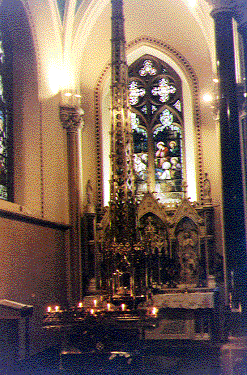

The reliquary holding the head of St. Oliver Plunkett. The head is in the glass case below the spire.
There were two reasons why I wanted to stay in Drogheda. The first reason is that it's close to Newgrange. The second reason is that it's the home of the relics of St. Oliver Plunkett. These relics rest inside of St. Peter's Church, which is on West Street. But these aren't just any relics. Inside a glass case in the north wing of the church rest the saint's head. It's not everyday that you get to see an actual saint's head. Since I'm somewhat fascinated by the macabre, this place seemed like a natural to visit.
A little about the saint is necessary before continuing the story. Oliver Plunkett was a bishop in Ireland in the mid 1600s. By most accounts, he was a very zealous individual who did much to reorganize the Church in Ireland. However, he ran afoul of the English authorities for his ecclesiastic activities. He was hanged, drawn and quartered, and beheaded on July 1, 1681. As was the practice at the time, his body was thrown into a fire after the execution. His parishoners managed to pull the head out of the fire before it was too badly burned (although you can see scorch marks on it today). The head was transported to Germany, where it was kept in a convent until the late 1800s. With the completion of St. Peter's Church, the head was moved back to Ireland for placement in a shrine dedicated to the saint.
We arrived at the church at about 8 p.m. I didn't think the building would be open, but it was. We went inside. The church was dark except for some light from the north transcept. We went toward the light. There was the shrine of St. Oliver Plunkett. The shrine is made up of several paintings depicting events in his life. Also there are the door of his jail cell and several bones from him. However, the centerpiece of the shrine is a glass case topped with a ten foot brass spire. Inside the case rests the head of the saint. It's surrounded by candles which illuminate it rather nicely. The head doesn't look like a living head. It is brown and dried like a mummy. However, one can still make out the ears and the lips and the eyelids. For something that's over 300 years old, it's in remarkable shape.
The point of this visit was to get a picture of the head itself. Unfortunately, the light inside the church was too dark for my camera to get a picture. But, my friend felt his digital camera could do the trick. While he was setting up the shot (mostly by waiting for other worshipers to leave the area), I walked around the church. It's a beautiful Neo- Gothic building. Even if the saint's relics didn't rest inside there, it would still be worth a visit. There is no charge to enter the church.
The last worshippers left and my friend, Tom Marihart, set up the shot. He ended up taking the picture directly facing the head. The glare of the flash totally blocked out any other feature in the picture. He took a step to the right, pressed the button, and got the picture for which we had come.
I have placed his picture on this web page. However, I don't place it here for lurid or morbid sensationalism. I do it in order to get people to reflect. When I looked at it, I didn't think that I was looking at a 300 year old head. I instead thought that it was a disturbing reminder of the sacrifices that people sometimes have to make in defense of what they believe. I hope that seeing it will cause you to reflect on the prejudices that led this man to his death.
If you wish to see the head of St. Oliver Plunkett, click here.